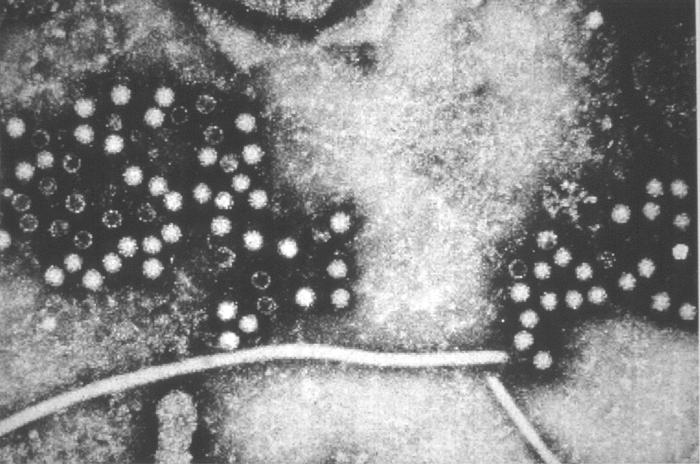Hepatitis E causes: Difference between revisions
Joao Silva (talk | contribs) |
Joao Silva (talk | contribs) |
||
| Line 36: | Line 36: | ||
*Continuous fecal shedding from [[asymptomatic]] patients was suggested as a form of maintenance of the [[HEV|virus]], contaminating water supplies.<ref name="pmid21932388">{{cite journal| author=Aggarwal R, Jameel S| title=Hepatitis E. | journal=Hepatology | year= 2011 | volume= 54 | issue= 6 | pages= 2218-26 | pmid=21932388 | doi=10.1002/hep.24674 | pmc= | url=http://www.ncbi.nlm.nih.gov/entrez/eutils/elink.fcgi?dbfrom=pubmed&tool=sumsearch.org/cite&retmode=ref&cmd=prlinks&id=21932388 }} </ref> | *Continuous fecal shedding from [[asymptomatic]] patients was suggested as a form of maintenance of the [[HEV|virus]], contaminating water supplies.<ref name="pmid21932388">{{cite journal| author=Aggarwal R, Jameel S| title=Hepatitis E. | journal=Hepatology | year= 2011 | volume= 54 | issue= 6 | pages= 2218-26 | pmid=21932388 | doi=10.1002/hep.24674 | pmc= | url=http://www.ncbi.nlm.nih.gov/entrez/eutils/elink.fcgi?dbfrom=pubmed&tool=sumsearch.org/cite&retmode=ref&cmd=prlinks&id=21932388 }} </ref> | ||
*The existence of an [[animal reservoir]] is supported by the detection of anti-[[HEV]] antibodies in different species.<ref name="pmid21932388">{{cite journal| author=Aggarwal R, Jameel S| title=Hepatitis E. | journal=Hepatology | year= 2011 | volume= 54 | issue= 6 | pages= 2218-26 | pmid=21932388 | doi=10.1002/hep.24674 | pmc= | url=http://www.ncbi.nlm.nih.gov/entrez/eutils/elink.fcgi?dbfrom=pubmed&tool=sumsearch.org/cite&retmode=ref&cmd=prlinks&id=21932388 }} </ref> | |||
==References== | ==References== | ||
Revision as of 20:12, 26 August 2014
|
Hepatitis E Microchapters |
|
Diagnosis |
|---|
|
Treatment |
|
Hepatitis E causes On the Web |
|
American Roentgen Ray Society Images of Hepatitis E causes |
Editor-In-Chief: C. Michael Gibson, M.S., M.D. [1]; Associate Editor(s)-in-Chief: João André Alves Silva, M.D. [2]
Overview
Taxonomy
Viruses; ssRNA viruses; ssRNA positive-strand viruses; Hepeviridae; Hepevirus; Hepatitis E virus[1]
Biology
 |
The viral particles are 27 to 34 nanometers in diameter, are non-enveloped and contain a single-strand of positive-sense RNA that is approximately 7300 bases in length. The virus particle was first visualised in 1983[3] but was only molecularly cloned in 1990.[4]
It was previously classified family Caliciviridae. However, its genome more closely resembles the rubella virus. It is now classified in a new virus family, named as Hepeviridae.
- Caused by the Hepatitis E virus (HEV)
- HEV is found in the stool (feces) of persons and animals with hepatitis E.
- HEV is spread by eating or drinking contaminated food or water.
- Transmission from person to person occurs less commonly than with hepatitis A virus
- Most outbreaks in developing countries have been associated with contaminated drinking water. [3]
Life Cycle
Genotypes
Tropism
Natural Reservoir
The natural reservoir of HEV is yet to be identified. Different observations have suggested different hosts:
- Prolonged fecal shedding from patients with history of the disease has been suggested. However, duration of viral shedding in feces is not compatible with this hypothesis.[5]
- Environmental reservoir was suggested due to detection of HEV in sewages.[6]
- Continuous fecal shedding from asymptomatic patients was suggested as a form of maintenance of the virus, contaminating water supplies.[7]
- The existence of an animal reservoir is supported by the detection of anti-HEV antibodies in different species.[7]
References
- ↑ "Hepatitis E virus taxonomy".
- ↑ "http://phil.cdc.gov/phil/details.asp". External link in
|title=(help) - ↑ Balayan MS, Andjaparidze AG, Savinskaya SS; et al. (1983). "Evidence for a virus in non-A, non-B hepatitis transmitted via the fecal-oral route". Intervirology. 20 (1): 23–31. PMID 6409836.
- ↑ Reyes GR, Purdy MA, Kim JP; et al. (1990). "Isolation of a cDNA from the virus responsible for enterically transmitted non-A, non-B hepatitis". Science. 247 (4948): 1335–9. doi:10.1126/science.2107574. PMID 2107574.
- ↑ Aggarwal R, Kini D, Sofat S, Naik SR, Krawczynski K (2000). "Duration of viraemia and faecal viral excretion in acute hepatitis E." Lancet. 356 (9235): 1081–2. doi:10.1016/S0140-6736(00)02737-9. PMID 11009149.
- ↑ Ippagunta SK, Naik S, Sharma B, Aggarwal R (2007). "Presence of hepatitis E virus in sewage in Northern India: frequency and seasonal pattern". J Med Virol. 79 (12): 1827–31. doi:10.1002/jmv.21017. PMID 17935174.
- ↑ 7.0 7.1 Aggarwal R, Jameel S (2011). "Hepatitis E." Hepatology. 54 (6): 2218–26. doi:10.1002/hep.24674. PMID 21932388.